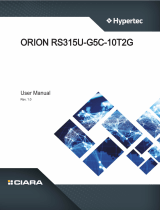
- 8 -
Chapter 4 Motherboard Components ...........................................................................52
4-1 Motherboard Components ............................................................................. 52
4-2 Jumper Setting .............................................................................................. 53
4-3 Backplane Board Storage Connector ............................................................. 54
4-3-1 CBPH081 ................................................................................................................54
Chapter 5 BIOS Setup ..................................................................................................55
5-1 The Main Menu .............................................................................................. 57
5-2 Advanced Menu ............................................................................................. 60
5-2-1 Trusted Computing .................................................................................................62
5-2-2 PSP Firmware Versions .......................................................................................... 63
5-2-3 Legacy Video Select ...............................................................................................64
5-2-4 AST2600 Super IO Conguration ...........................................................................65
5-2-5 S5 RTC Wake Settings ...........................................................................................67
5-2-6 Serial Port Console Redirection .............................................................................68
5-2-7 CPU Conguration ..................................................................................................72
5-2-8 PCI Subsystem Settings .........................................................................................73
5-2-9 USB Conguration ..................................................................................................75
5-2-10 Network Stack Conguration ..................................................................................77
5-2-11 NVMe Conguration ...............................................................................................78
5-2-12 SATA Conguration.................................................................................................79
5-2-13 Graphic Output Conguration .................................................................................80
5-2-14 AMD Mem Conguration Status .............................................................................81
5-2-15 Tls Auth Conguration ............................................................................................82
5-2-16 RAM Disk Conguration .........................................................................................83
5-2-17 iSCSI Conguration ................................................................................................84
5-2-18 Intel(R) I350 Gigabit Network Connection ..............................................................85
5-2-19 VLAN Conguration ................................................................................................87
5-2-20 MAC IPv4 Network Conguration ...........................................................................88
5-2-21 MAC IPv6 Network Conguration ...........................................................................89
5-3 AMD CBS Menu ............................................................................................. 90
5-3-1 CPU Common Options ...........................................................................................91
5-3-2 DF Common Options ..............................................................................................97
5-3-3 UMC Common Options ........................................................................................103
5-3-4 NBIO Common Options ........................................................................................123
5-3-5 FCH Common Options .........................................................................................133
5-3-6 NTB Common Options .........................................................................................142
5-3-7 SOC Miscellaneous Control .................................................................................143
5-3-8 Workload Tuning ...................................................................................................145
5-3-9 CXL Common Options ..........................................................................................146
5-4 AMD PBS Menu ........................................................................................... 147




















